Contacts:
Rebecca L. Shuford, NYSG’s Director, E: Rebecca.Shuford@stonybrook.edu, P (631) 632-6905
Katherine Bunting-Howarth, NYSG’s Associate Director, E: keb264@cornell.edu, P (607) 255-2832
Lane Smith, NYSG’s Research Program Coordinator, E: Lane.Smith@stonybrook.edu, P: (631) 632-9780
Paul C. Focazio, Communications Manager, NYSG, E: paul.focazio@stonybrook.edu, P: (631) 632-6910
New York, NY, October 15, 2020 - New York Sea Grant (NYSG) has awarded over $2.1 million to support six coastal science research projects that explore topics relating to and benefiting New York’s coastal environment, communities and economies. The projects are sponsored by NYSG and funded through the National Oceanic and Atmospheric Administration (NOAA), Sea Grant’s federal parent agency.
“New York Sea Grant is excited to announce six new projects selected through our biennial call for research proposals,” said NYSG Director Dr. Becky Shuford. “After a thorough peer review process followed by a technical review panel, projects were selected that address a variety of research topics and cover the diverse geography of our State as well as multiple subjects of interest to our stakeholders.
“This set of projects – addressing topics such as coastal processes and community flood resilience, microplastic impacts on benthic organisms and environments, aquaculture studies to support understanding of the potential of shellfish and macroalgae operations, and habitat restoration – will contribute to the long-standing and growing body of NYSG-supported science-based knowledge available to coastal communities in New York State.”
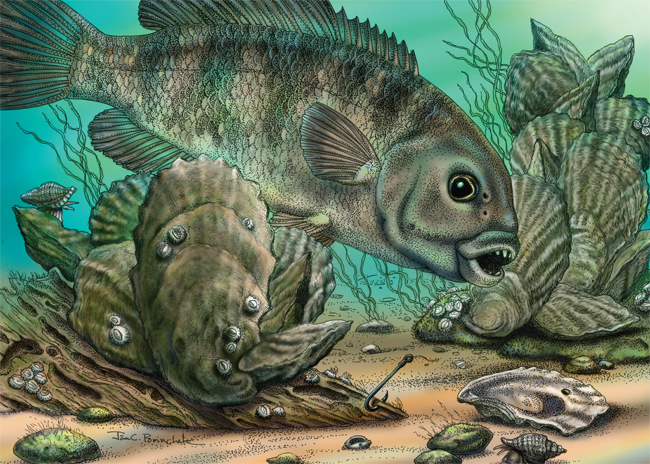
Oyster reefs were once a dominant feature of estuaries along the Atlantic and Gulf of Mexico coasts with healthy communities of eastern oyster. New research supported by NY Sea Grant will provide information to support oyster restoration efforts in NY/NJ harbor. Credit: Jan Porinchak
Identification of Superior Diploid and Triploid Oyster Lines for Aquaculture Operations in New York (Stony Brook University)
Oyster aquaculture represents a sustainable industry that contributes to the economies of local coastal communities.
Dr. Bassem Allam, of Stony Brook University’s (SBU) School of Marine and Atmospheric Sciences (SoMAS), is leading a research team including Drs. Emmanuelle Pales-Espinosa and Robert Cerrato, also of SoMAS, and Cornell Cooperative Extension’s Gregg Rivara in a study comparing the performance of different oyster lines derived from different genetic backgrounds. Further, the team will contrast the performance of locally-derived triploid oysters with that of their diploid counterparts.
Superior oyster lines identified during the study will be maintained and broadly distributed to the aquaculture industry in the state and beyond. New York consumers will benefit from an increased availability of high quality and competitively priced oyster products.
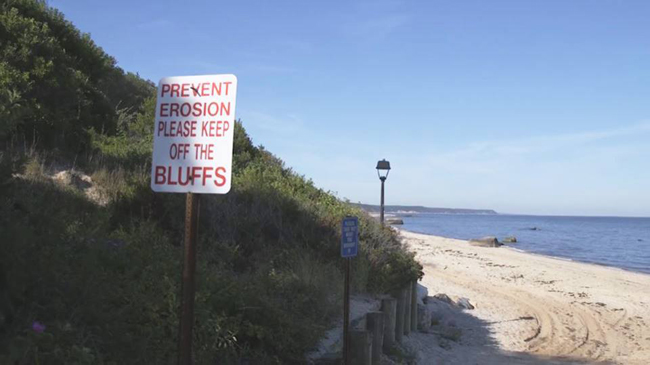
In an effort to help prevent erosion, signage encourages beachgoers to keep off coastal bluffs. New research supported by NY Sea Grant will provide information that will allow for improved prediction of bluff erosion that informs planning by coastal communities. Credit: Cornell Extension Marine Program
Erosion and Recession of Coastal Bluffs: Characterizing Erodibility of Bluff Materials under Various Land- and Sea-Based Conditions (Stony Brook University)
Coastal bluffs comprise a significant percentage of shorelines in the Great Lakes, U.S. Atlantic and Pacific Coasts. Erosion and recession of bluffs are an issue of concern to coastal communities and are being more frequently and extensively impacted by rising sea levels, extended droughts, heavier rainfall, and coastal storms.
Dr. Ali Farhadzadeh of both SBU’s Department of Civil Engineering and SoMAS and Dr. Henry Bokuniewicz of SoMAS will conduct a study to identify and quantify some of the underlying processes, both sea- and land-based that lead to coastal bluff erosion. With an enhanced understanding of the factors involved with bluff recession gained through this project, a modeling framework that improves prediction of bluff erosion is expected. The developed model could also be used to identify risk areas where shoreline protection measures, including natural and nature-based features, could prevent or slow further recession.
The results will be useful for resource managers and property owners to better predict and respond to future erosion under varying climate changes.
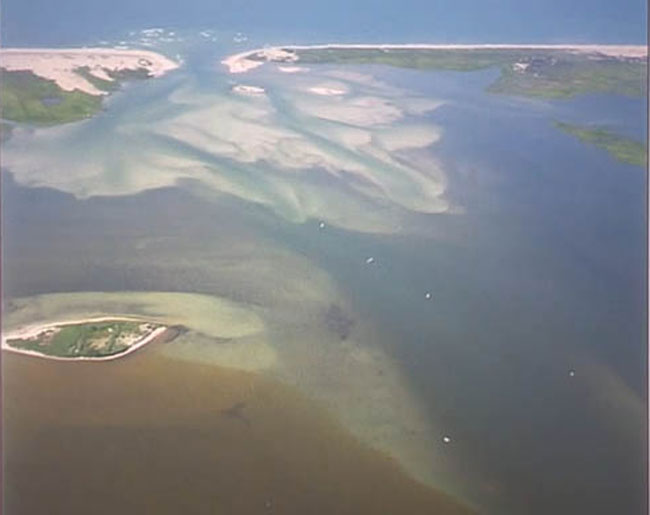
Long Island’s Great South Bay became clearer during the 2019 season due to a new inlet but it is not immune to brown tides and other harmful algal blooms (HABs). New research supported by NY Sea Grant will develop and test shellfish aquaculture techniques that integrate macroalgae culture. Macroalgae have been shown to help control a variety of HABs populations. Credit: Chris Gobler
The Use of Macroalgae to Expand Aquaculture and Prevent, Control, and Mitigate Harmful Algal Blooms in New York’s Coastal Zones (Stony Brook University)
During the past several decades, harmful algal blooms (HABs) have had significant environmental and economic consequences in New York’s coastal waters.
Drs. Chris Gobler and Michael Doall of SBU’s SoMAS will conduct a study to assess the ability of cultivable macroalgae to inhibit the growth of HAB species common to NY waters while also expanding potential aquaculture opportunities.
Previous studies have shown that macroalgae can inhibit the growth of HAB species through several mechanisms, including pH elevation, competition for nutrients, algicidal bacteria associated with macroalgae that produce allelochemicals that inhibit HABs species. The study will develop and assess cultivation techniques and test the feasibility of co-culturing HAB-combative seaweeds with bivalve shellfish at commercially viable scales on shellfish farms.
The expected results of this project are the development of seaweed cultivation best practices and guidance materials that can be used by aquaculture operators and will create an opportunity to both expand the scope of the New York aquaculture industry and introduce a cost-effective method for mitigating HABs.
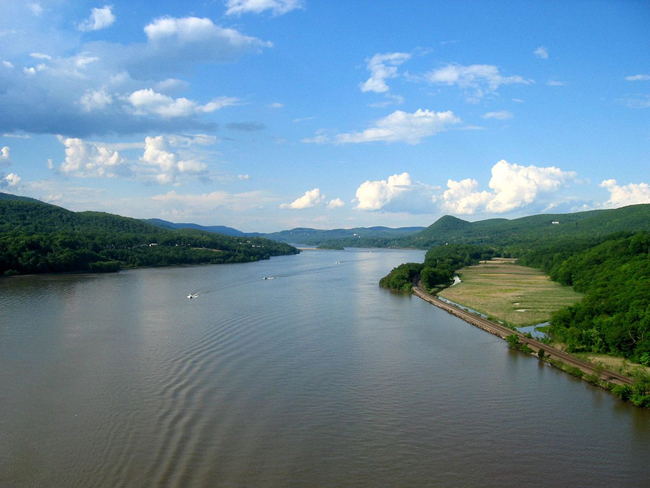
The Hudson River, as seen from the Bear Mountain Bridge
Optimizing Restoration to Promote Ecosystem Services in New York Harbor Using Ecosystem Models (Cornell University)
The Hudson/Raritan Estuary (HRE) or NY/NJ Harbor Estuary was once home to large and robust populations of eastern oysters.
A research team led by Cornell University’s Dr. Matthew Hare—including partners from the Billion Oyster Project, University of Maryland Horn Point Laboratory, Norwich University, and the University of Maine's Darling Marine Center—aims to help improve the effectiveness of oyster restoration efforts, by developing an ecosystem model that couples hydrodynamics, water quality, and oyster biophysics to simulate how swimming larvae are transported to and from reefs. This will help in choosing the best sites for placing oysters.
The ecosystem model will be available for planners to map locations with the highest chances of promoting future oyster recruitment, aiding efforts to grow self-sustaining oyster populations in the estuary.
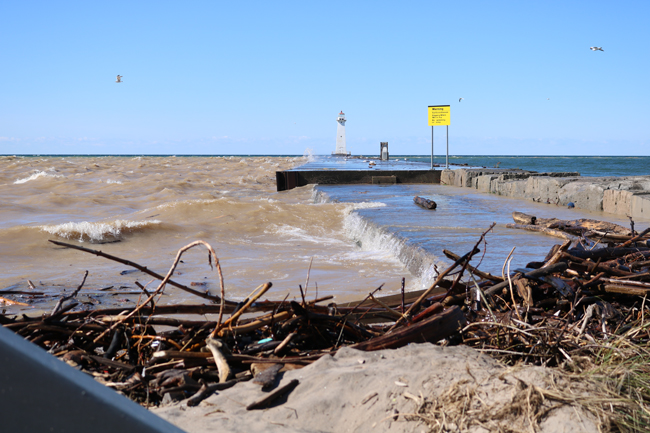
Record level flooding has been a challenge for coastal communities along Lake Ontario. New research supported by NY Sea Grant will provide information that will help communities apply for assistance through The New York Climate Smart Communities Program. Credit: Mary Austerman/NYSG
Using Hydroclimate Modeling and Social Science to Enhance Flood Resilience on Lake Ontario through the Climate Smart Communities Program (Cornell University)
In the summer of 2017, shoreline communities along Lake Ontario suffered the worst flood event on record, driven by seasonal precipitation that far exceeded historic events over the last century. In 2019, water levels once again set records, rising above the 2017 peak following heavy winter-spring precipitation. In the wake of these events, coastal communities in New York feel that they lack the ability to adapt to heightened flood risk under continued changes in regional water levels.
The New York Climate Smart Communities (CSC) Program is a State program that helps local governments adapt to a changing climate. However, participation in the program among Lake Ontario municipalities is low, in part because of the requirement for municipalities to demonstrate the need for a project based on an assessment of future conditions derived from scientifically supported climate projections.
To assist communities meet the requirements of the Program, Cornell University’s Dr. Scott Steinschneider is leading a research team including Drs. Bruce Lauber, Richard Stedman, and Barbara Knuth also at Cornell University, Dr. Andrew Gronewald at University of Michigan, and Dr. Jayme Thomann, then with the Genesee/Finger Lakes Regional Planning Council to develop and integrate modeling tools and social-science based recommendations to help Lake Ontario coastal communities better meet the CSC Program requirements and adapt to future coastal flooding.
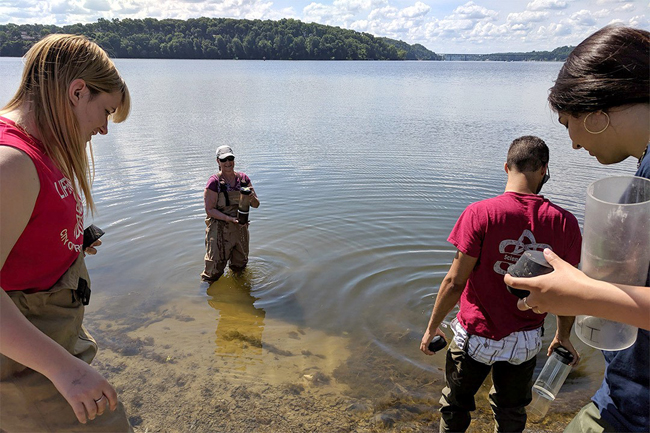
RIT researchers received funding to study the effects of microplastic pollution on Lake Ontario. This new research supported by NY Sea Grant will provide information on the potential impacts microplastics can have on the ecosystem services in Great Lakes sediments. RIT Associate Professor Christy Tyler, center, is pictured collecting sediment samples in Irondequoit Bay in 2019. Credit: Matthew Hoffman/RIT.
Impacts of Microplastic Pollution on Benthic Ecosystem Functions and Services (Rochester Institute of Technology)
Microplastics are a contaminant of growing concern as their widespread presence in many ecosystems is increasingly observed. However, little is known about their impacts on ecosystem function, especially in sediments of freshwater ecosystems.
A research team at Rochester Institute of Technology led by Dr. Christy Tyler aims to help address this knowledge gap in Lake Ontario’s New York waters.
The study will combine sediment sample analysis with three-dimensional transport modeling to produce the first known estimates of polymer-specific plastic flux to the sediment in the Great Lakes. These estimates will then inform toxicity experiments at environmentally relevant concentrations to assess effects on key organisms to estimate the potential impact of microplastics on benthic ecosystem function.
Results from the study should provide information and tools to inform future research and policy.
More Info: New York Sea Grant
New York Sea Grant (NYSG), a cooperative program of Cornell University
and the State University of New York (SUNY), is one of 34 university-based
programs under the National Oceanic and Atmospheric Administration’s
National Sea Grant College Program.
Since 1971, NYSG has represented a statewide network of integrated
research, education and extension services promoting coastal community
economic vitality, environmental sustainability and citizen awareness
and understanding about the State’s marine and Great Lakes resources.
Through NYSG’s efforts, the combined talents of university scientists
and extension specialists help develop and transfer science-based
information to many coastal user groups—businesses and industries,
federal, state and local government decision-makers and agency managers,
educators, the media and the interested public.
The program maintains Great Lakes offices at Cornell University, University at Buffalo, SUNY Oswego and the Wayne County Cooperative Extension office
in Newark. In the State's marine waters, NYSG has offices at Stony Brook
University in Long Island, Brooklyn College and Cornell Cooperative
Extension in NYC and Kingston in the Hudson Valley.
For updates on Sea Grant activities: www.nyseagrant.org has RSS, Facebook, Twitter, Instagram, and YouTube links. NYSG offers a free e-list sign up via www.nyseagrant.org/nycoastlines for its flagship publication, NY Coastlines/Currents, which is published quarterly. Our program also produces an occasional e-newsletter,"NOAA Sea Grant's Social Media Review," via its blog, www.nyseagrant.org/blog.